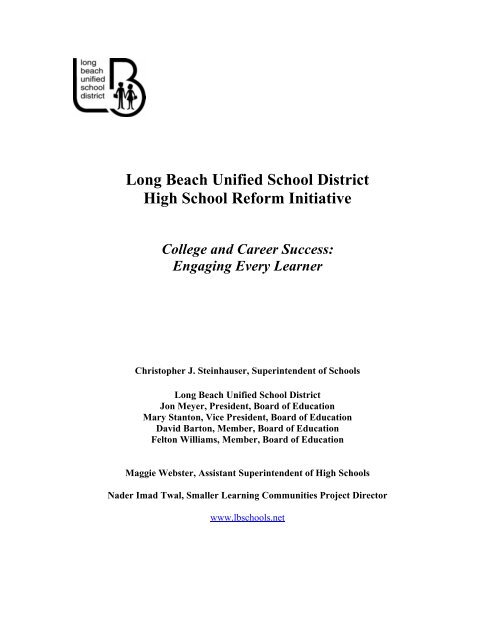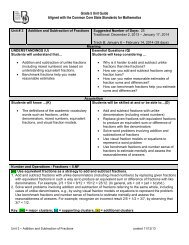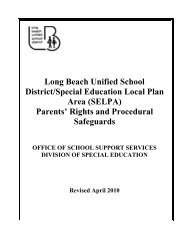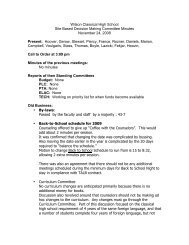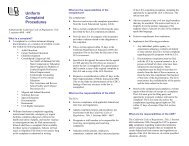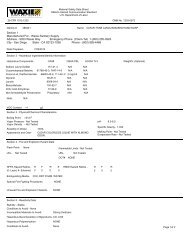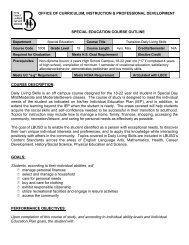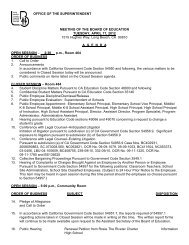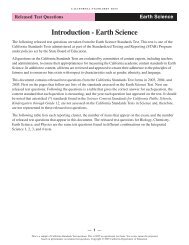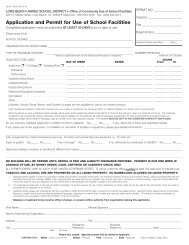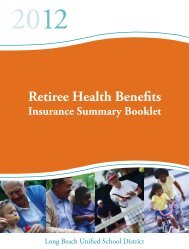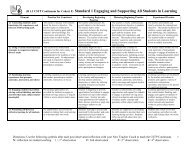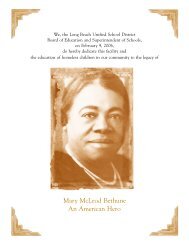Long Beach Unified School District High School Reform Initiative
Long Beach Unified School District High School Reform Initiative
Long Beach Unified School District High School Reform Initiative
Create successful ePaper yourself
Turn your PDF publications into a flip-book with our unique Google optimized e-Paper software.
<strong>Long</strong> <strong>Beach</strong> <strong>Unified</strong> <strong>School</strong> <strong>District</strong><br />
<strong>High</strong> <strong>School</strong> <strong>Reform</strong> <strong>Initiative</strong><br />
College and Career Success:<br />
Engaging Every Learner<br />
Christopher J. Steinhauser, Superintendent of <strong>School</strong>s<br />
<strong>Long</strong> <strong>Beach</strong> <strong>Unified</strong> <strong>School</strong> <strong>District</strong><br />
Jon Meyer, President, Board of Education<br />
Mary Stanton, Vice President, Board of Education<br />
David Barton, Member, Board of Education<br />
Felton Williams, Member, Board of Education<br />
Maggie Webster, Assistant Superintendent of <strong>High</strong> <strong>School</strong>s<br />
Nader Imad Twal, Smaller Learning Communities Project Director<br />
www.lbschools.net
TABLE OF CONTENTS<br />
Introduction…………………………………………………………………………………………… 3<br />
Section I. College and Career Success: Engaging Every Learner………………………………… 5<br />
Section II. Moving Forward With <strong>Reform</strong>…………………………………………………………. 16<br />
Section III. Evaluation Plan……………………………………………………………………...….. 22<br />
Conclusion…………………………………………………………………………………………..... 24<br />
Chart: <strong>High</strong> <strong>School</strong> <strong>Reform</strong> at a Glance………………………………………………………..….. 25<br />
Chart: <strong>Long</strong> <strong>Beach</strong> <strong>Unified</strong> <strong>School</strong> <strong>District</strong> <strong>High</strong> <strong>School</strong> Profiles…………………………….….. 27<br />
2
College and Career Success: Engaging Every Learner<br />
INTRODUCTION<br />
As part of the district’s larger strategic plan to help ensure that all students graduate from high<br />
school with options to pursue various academic and career pathways, the <strong>High</strong> <strong>School</strong> <strong>Reform</strong><br />
<strong>Initiative</strong> (HSRI) and the <strong>District</strong> <strong>Initiative</strong> for Expanding Pathways (a subset of the HSRI) align<br />
seamlessly with the LBUSD district vision as articulated in the Academic and Career Success<br />
<strong>Initiative</strong>. Both documents currently guide professional development and redesign for <strong>Long</strong><br />
<strong>Beach</strong> high schools over the course of the next five years. <strong>District</strong> personnel, school board<br />
members, and key community partners participate in the professional development efforts to<br />
build and sustain leadership capacity that supports multiple pathway design. As multiple<br />
pathways take root, every comprehensive high school in <strong>Long</strong> <strong>Beach</strong> will articulate a plan for<br />
college “A-G” course awareness, access, and completion; college and career awareness and<br />
enrichment; parent outreach about postsecondary options; enhanced counseling to support<br />
multiple pathways; mentoring programs for students; early algebra readiness and completion<br />
programs; literacy development support programs; enhanced interventions to prevent further<br />
remediation; AVID program expansion; and Advanced Placement course expansion. At the heart<br />
of the Academic and Career Success <strong>Initiative</strong> lie three enhancements to this effort: 1) Informing<br />
students and parents of “A-G” college entrance requirements beginning in the sixth grade; 2)<br />
establishing student benchmarks for guaranteed college admission; and 3) Aligning these higher<br />
education efforts with Career Technical Education programs.<br />
As such, the <strong>High</strong> <strong>School</strong> <strong>Reform</strong> <strong>Initiative</strong> Goals, which will guide the work through 2014,<br />
enhance this work with an emphasis on: (1) Implementing a rigorous and relevant<br />
multidisciplinary curriculum in the academic core resulting in increased student achievement; (2)<br />
providing all students with a sequenced and aligned technical curriculum, including work-based<br />
learning and Career Technical Education (CTE)/Regional Occupations Program (ROP)<br />
experiences, for career exploration; (3) providing consistent and sustained support, including<br />
prevention and intervention, to ensure that all students achieve their maximum potential; and (4)<br />
creating a holistic campus climate where relationships, social behavior, and positive professional<br />
interactions lead to academic success.<br />
The <strong>High</strong> <strong>School</strong> Office Goals for 2008-2010 further this effort by specifically focusing attention<br />
on: (1) Preparing all students for postsecondary education and careers; (2) Providing intensive<br />
interventions to ensure their success along the way; and (3) and enrolling and supporting students<br />
in a coherent sequence of rigorous courses that allows them to have postsecondary options upon<br />
graduation. Site-level school improvement plans and professional development efforts must<br />
advance these goals for their particular demographics in order to close the achievement gap.<br />
Department and smaller learning community professional development efforts and action plans<br />
articulate the differentiated and program-specific approaches that sites will take to attain these<br />
goals. Finally, all instructional practices within the classroom act as the nexus between planning<br />
and implementation, where objectives and action steps defined in these plans become embedded<br />
in the student experience.<br />
3
The Seamless Education Partnership, which supports K-16 collaboration models, will continue to<br />
promote the “<strong>Long</strong> <strong>Beach</strong> College Promise,” a joint commitment between LBUSD, LBCC, and<br />
CSULB to make college an attainable goal for all students. The Promise provides the following<br />
educational benefits and services: a tuition free semester at LBCC to begin by 2011; guaranteed<br />
college admission to CSULB for students who successfully complete the minimum college<br />
preparatory or transfer requirements; early and continued outreach to students and parents<br />
beginning in the sixth grade and continuing through college; and support for the various<br />
pathways to higher education that students may choose to take. To support a college going and<br />
career ready culture at each of the local high schools, the Seamless Education Partnership has<br />
articulated three initiatives to inform some of its work in this area: 1) the infusion and acceptance<br />
of the CSULB Early Assessment Program (EAP) at the LBCC campus, as well as the alignment<br />
of intervention courses at LBUSD, LBCC, and CSULB to allow for reciprocity; 2) the support<br />
and development of career and technical education pathways in the high school course of study<br />
in collaboration with LBUSD, LBCC, CSULB, and business partners; and 3) the intentional<br />
integration of relevance into all courses by working with all three academic institutions and the<br />
business sector to define rigor, and design sample student assignments that reflect this<br />
commitment.<br />
In five to seven years, all pathway students will receive quality instruction in rigorous, standardsbased<br />
academic and technical curricula that ensures access to, and readiness for, both career<br />
opportunities and a full range of postsecondary options: two- and four-year colleges and<br />
universities, apprenticeships, the military, and formal career training. Student outcome charts for<br />
each small learning community will describe the unique attributes that a student in its particular<br />
industry sector and career pathway should demonstrate to reflect mastery of academic and career<br />
based content beyond the California Standards for the core subject areas. Each Smaller Learning<br />
Community (SLC) will have a designated counselor familiar with its unique needs and capable<br />
of delivering formalized, sequenced college and career counseling. ROP and CTE courses will<br />
seamlessly enhance the academic course of study with relevant technical curricula. Industry and<br />
business partners will offer rich and on-site work-based experiences through clearly defined and<br />
aligned apprenticeships, mentorships, and internships.<br />
A clear indication of the successful design and implementation of multiple pathways will be<br />
evidenced in a minimum 20% increase in the “a-g”/college entrance requirements completion<br />
rate; a minimum 10% participation rate in the AVID program at all middle and high schools; a<br />
statistically significant increase in AP enrollment and pass rates; an increase in the Early<br />
Assessment Program participation and performance; and a statistically significant rise in students<br />
with multiple options upon graduation. Prior to graduation, high schools should also see a<br />
significant increase in the number of students enrolled in CTE courses, ROP offerings, workstudy<br />
experiences, and mentorship programs aligned with their particular course of study. Data<br />
systems in the Research Department of LBUSD provide accurate and meaningful measures of<br />
program performance; assessment instruments; and a commitment to common evaluation of<br />
implementation success.<br />
4
SECTION I. COLLEGE AND CAREER SUCCESS: ENGAGING EVERY LEARNER<br />
<strong>High</strong> <strong>School</strong> <strong>Reform</strong> Goals and Indicators<br />
The work of reforming secondary schools has crystallized into the following four goals and<br />
indicators, which are guiding the high school initiative. Each goal is accompanied by a more<br />
specific set of indicators that will be used to measure the progress of the high school initiative.<br />
Goal 1: Implement a rigorous and relevant multidisciplinary curriculum in the academic<br />
core resulting in increased student achievement.<br />
Indicators of Success:<br />
o Meet or exceed No Child Left Behind (NCLB) Adequate Yearly Progress (AYP) –<br />
Annual Measurable<br />
Objectives growth targets<br />
o Meet or exceed Academic Performance Index (API) growth targets<br />
o Increase the number of students:<br />
- passing California <strong>High</strong> <strong>School</strong> Exit Exam (CAHSEE) on the first attempt in<br />
10th grade<br />
- scoring proficient on district End of Course (EOC) exams<br />
- meeting the University of California/ California State University A-G<br />
requirements<br />
- enrolled in higher level courses (i.e. accelerated, honors, and AP courses)<br />
- enrolled in and successfully completing the AVID program<br />
- participating in the <strong>Long</strong> <strong>Beach</strong> College Promise<br />
o Improve high school graduation rates<br />
Goal 2: Provide all students with a sequenced and aligned technical curriculum, including<br />
work-based learning and CTE/ROP experiences, for career exploration.<br />
Indicators of Success:<br />
o Increase number of students<br />
- enrolled in and successfully completing CTE/ROP related courses<br />
- participating in and successfully completing internships, focused field trips, job<br />
shadows, and other work-related experiences<br />
o Increase the number of CTE courses that meet A-G aligned to each pathway<br />
o Increase rubric on the ConnectEd Multiple Pathways Rubric Assessment in all areas<br />
pertaining to technical and work-based curricula<br />
o Increased scores on the Ford Partnership for Advanced Studies (PAS) 12-Point Master<br />
Plan and Indicators of Success Assessment Tool<br />
5
Goal 3: Provide for consistent and sustained support, including prevention and<br />
intervention, to ensure that all students achieve their maximum potential.<br />
Indicators of Success:<br />
o Meet or exceed NCLB AYP growth targets with specific subgroups<br />
o Meet or exceed California API growth targets with specific subgroups<br />
o Increase the number of, low SES (Socio-Economic Status), African-American,<br />
Hispanic, English Language Learner and Special Education students:<br />
- enrolled in the AVID (Advancement Via Individual Determination) elective<br />
courses<br />
- scoring proficient on End Of Course exams<br />
- passing CAHSEE in grade 10<br />
- who take college entrance tests, such as PSAT, SAT, ACT and the Early<br />
Assessment Program (EAP) assessment, and scoring at national or local<br />
averages.<br />
- graduating from high school (i.e. Increase graduation rate) rates<br />
- completing three years of mathematics to include algebra, geometry, and either<br />
intermediate algebra (algebra 2) or statistics<br />
- who meet the A-G college eligibility requirements<br />
- enrolled in “higher level courses” (i.e. accelerated, honors, and AP courses)<br />
o Reduce the numbers of low SES, African-American, Hispanic, English Language<br />
Learner and Special Education students who score Far Below Basic and Below Basic<br />
on California Standards Tests<br />
o Reduce the numbers of 10th-12th students needing reading intervention courses (i.e.<br />
reading two or more years below grade level)<br />
o Reduce the numbers of 10th-12th grade students needing math intervention courses<br />
(i.e. courses prior to Algebra 1)<br />
o Increase high school graduation rates<br />
o Increase tutorial attendance of below grade level students<br />
o Reduce high school drop-out rates<br />
o Improve grade cohort retention (i.e. reduced numbers of credit-deficit students)<br />
Goal 4: Create a holistic campus climate where relationships, social behavior, and positive<br />
professional interactions lead to academic success.<br />
Indicators of Success:<br />
o Increase the numbers of students belonging to small learning communities or having<br />
regular contact with a personal adult advocate on campus<br />
o Increase student-reported levels of security, feelings of respect for other students and<br />
faculty, and increased academic aspirations on Western Association of <strong>School</strong>s and<br />
Colleges (WASC) and other surveys<br />
o Improve student attendance (both entire day and period attendance)<br />
o Decrease the number of referrals and suspensions<br />
o Reduce violent incidences on campus<br />
6
o Provide increased student/counselor contact<br />
o Increased student membership in school clubs and organizations<br />
o Increase parental participation in school outreach programs<br />
o Increase parental satisfaction as measured by WASC and/or districts surveys<br />
o Increase regular collaboration time for teachers in their Professional Learning<br />
Communities to discuss lessons, student work, assessment results, and plans for<br />
instructional improvement.<br />
o Increase and embed structures for continued professional learning for principals to<br />
improve and sustain reform – principal institutes, time for PLC work, walk-throughs,<br />
site-based leadership team retreats, administrative team meetings, PLC Institutes<br />
o Empower teacher leaders – department heads, Small Learning Communities<br />
coordinators and lead teachers, Professional Learning Communities (PLCs), coaches –<br />
to examine critical instructional issues as evidenced by student data to meet the needs<br />
of all students<br />
<strong>Reform</strong> Strategies: 2005-Present<br />
The <strong>Long</strong> <strong>Beach</strong> <strong>Unified</strong> <strong>School</strong> <strong>District</strong> <strong>High</strong> <strong>School</strong> <strong>Reform</strong> efforts are governed by a clear set<br />
of core beliefs about educational leadership: "Leadership requires a sense of mission and vision<br />
driven by passion and practical means of accomplishing goals. Successful Leadership includes<br />
effectively creating, nurturing, and channeling myriad relationships toward common goals."<br />
LBUSD uses the following five strategies in the development of high school reform efforts.<br />
These strategies are refined and adjusted as needed and provide the basis for the next phase of<br />
the initiative.<br />
Strategy 1: <strong>High</strong> <strong>School</strong> Principal Leadership Development<br />
Beginning in June 2002, high schools began the work of creating on-going structures for<br />
developing and improving the professional learning of principals. Focus Groups, professional<br />
learning communities, annual Principal Institutes and high school walk-throughs all provide<br />
forums for principals to deepen their understanding and ability to use student achievement data<br />
to drive reform efforts while building principal leadership capacity.<br />
Principal focus groups guide leadership activities. Four professional learning groups meet<br />
regularly to analyze research on best practices to: (1) develop structures and processes focused<br />
on climate, culture and communication ensuring safe environments that foster student learning;<br />
(2) develop and implement transitional approaches for alternative education including: Guidance<br />
Opportunity Class (GOC), Reid <strong>High</strong> <strong>School</strong>, and Educational Partnership <strong>High</strong> <strong>School</strong> (EPHS)<br />
students in collaboration with Student Support Services, career, technical, and alternative<br />
education; (3) use the Teaching Collaborative Model to implement strategies and provide<br />
intervention options that will prepare students to successfully pass the California <strong>High</strong> <strong>School</strong><br />
Exit Exam (CAHSEE) and access learning opportunities that are rigorous and challenging; and<br />
(4) implement strategies for transforming high schools in the following core areas: collaborative<br />
leadership, personalization, curriculum, instruction, and assessment based on the Breaking Ranks<br />
II: Supporting the Leaders of <strong>High</strong> <strong>School</strong> <strong>Reform</strong> model. Professional learning groups<br />
7
participate in an annual professional development series through the Principals’ Partnership<br />
(sponsored by Union Pacific), summer institutes through the International Center for Leadership<br />
in Education, pathway trainings through ConnectEd: The California Center for College and<br />
Careers and the James Irvine Foundation that deepen their knowledge of national school reforms<br />
and build collegiality and consistency across schools.<br />
Policy and practice: Literacy and Smaller Learning Communities. Based on<br />
recommendations from these professional learning groups, principals, district curriculum leaders,<br />
school departments heads and teacher coaches created a Literacy committee to deepen<br />
understanding of literacy strategies that support student achievement and to align district-wide<br />
policies and practices. Additionally, the <strong>High</strong> <strong>School</strong> Office created a Smaller Learning<br />
Communities Office to guide the work of creating a coherent, rigorous, and relevant course of<br />
study for all students at LBUSD high schools. These committees/offices are charged with<br />
guiding and shaping district policy and practices of these two focal areas of instruction and<br />
curriculum, with an emphasis on differentiation, data-driven practices, and continuous student<br />
improvement (Cycle of Inquiry).<br />
Key results walk-throughs. The purpose of the key results walk-throughs is to strengthen the<br />
dialogue among district support staff, school leaders, and teachers about ways to improve student<br />
achievement, including the school’s efforts and progress over time and the central office’s<br />
support to the schools. These walk-throughs are conducted for a half-day at each high school,<br />
two specialized program schools, and two alternative schools two times a year. The walkthrough<br />
teams include assistant superintendent for high schools, central office staff (including<br />
the smaller learning communities project director), curriculum leaders, the school’s<br />
administrative staff, site-based smaller learning communities coordinator, department heads,<br />
teacher coaches and teachers.<br />
o An essential component of the walk-through process is the development of systems for<br />
communicating feedback from walk-through teams to campus faculties. With this<br />
information, sites make decisions about how to use feedback to shape departmental or<br />
whole faculty professional development.<br />
<strong>High</strong> <strong>School</strong> principals’ meetings & walk throughs address annual priority theme. The<br />
Assistant Superintendent of <strong>High</strong> <strong>School</strong>s leads monthly principal meetings to consider and<br />
address reform and operational issues. Professional development for principals is a regular<br />
feature of the principal meetings and there is an annual theme for professional development<br />
activities. For example, in 2005-06, every three months the Assistant Superintendent of <strong>High</strong><br />
<strong>School</strong>s, all principals, curriculum leaders, central office staff and the schools’ assistant<br />
principals participated in walk-throughs that focused on specific data-driven differentiation<br />
supported by curriculum leaders across content areas. In 2006-07, aligning school improvement<br />
plans to high school office goals and developing a comprehensive site action plan for student<br />
improvement were the professional development foci and in 2007-2008, the focus was on<br />
implementing curricula that are both rigorous and relevant in order to engage all students in<br />
meaningful learning experiences and improve student achievement as defined by the Academic<br />
and Career Success <strong>Initiative</strong>. These walk-throughs deepen the understanding of participants<br />
about key strategies and ways to monitor and support teachers in their use.<br />
8
Strategy 2: <strong>School</strong> Level Professional Learning Communities – Development of<br />
Distributed Leadership<br />
In spring 2003, a team of high school principals attended a national leadership institute around<br />
the topic of creating the will and the structures to change high schools. At this session principals<br />
had the opportunity to listen and learn from Dr. Andy Hargreaves about the structure and<br />
purpose of Professional Learning Communities (PLCs) as a reform strategy. As a result,<br />
principals decided to embark on a process to learn more about how PLCs contribute to<br />
improving student achievement.<br />
Since these initial planning sessions, site-based Instructional Leadership Teams, focused on<br />
matters regarding curriculum and instruction, gather for district led PLC Institutes twice a year.<br />
The focus for 2007-2010 has been the Rigor, Relevance, and Relationship Framework, as well as<br />
building brain-compatible learning environments, and has been guided by the expertise and work<br />
of Dr. Willard Dagget and the International Center for Leadership in Education. Since these<br />
leadership teams are comprised of department heads, smaller learning community lead teachers,<br />
administrators, counselors, and clerical staff, the integration of the professional development<br />
school-wide becomes more comprehensive. Between sessions, each school’s professional<br />
learning community developed an action plan for their work in addressing high school reform<br />
goals.<br />
The Action Plan is a key element of the school and district reform. It provides a coordinated<br />
method for each school site to determine how it will address the goals of the high school reform.<br />
The Professional Learning Communities at each site use the plan to reflect and guide progress.<br />
Not all high schools are at the same point on the reform continuum.<br />
Strategy 3: Redesign of Professional Development<br />
To support the implementation of a rigorous and relevant multidisciplinary curriculum in the<br />
academic core resulting in increased student achievement [Goal 1], <strong>Long</strong> <strong>Beach</strong> high schools<br />
will focus on:<br />
Closing the achievement gap in literacy. Since the mid 1990’s the district has made concerted<br />
efforts to better use student achievement data to identify the academic needs of all students in<br />
order to place them in appropriate intervention courses as recommended by the<br />
Reading/Language Arts Framework for California Public <strong>School</strong>s (2007).<br />
The district has embraced the three tiered Response to Instruction and Intervention (RtI 2 ) system<br />
that connects general, gifted, categorical programs, and special education in providing high<br />
quality standards-based literacy instruction / intervention that is matched to the students’<br />
academic needs as follows:<br />
Tier I – A research-based high quality program (Holt or similar state approved textbook) is<br />
provided in all general education English classes.<br />
9
Tier II – Various interventions (Language!, CAHSEE support) are provided to students identified<br />
as reading two or more years below grade level and who require specific supports to make<br />
adequate progress in general education.<br />
Tier III – An intervention (Intensive Reading Clinic) is provided to students with intensive needs<br />
based on comprehensive evaluation.<br />
□ Progress Monitoring:<br />
The high school English departments have begun the work of aligning the “Key<br />
Components of an Effective Language Arts Department” (RLA Framework – 2007) with<br />
their site and department action plans.<br />
Closing the achievement gap in mathematics. The district’s math professional development<br />
will support the high school focus on developing rigorous and relevant (Quadrant D) lessons in<br />
all math courses for all students. The district will also continue to provide math professional<br />
development on active participation strategies and cooperative learning techniques to increase<br />
student engagement levels across all math courses. The district will train and support principals,<br />
department heads and math teachers with the expectation that during every class period, a variety<br />
of instructional strategies are employed every five to eight minutes throughout the lesson to<br />
ensure maximum student engagement. In addition, the district's research department, math<br />
curriculum coaches, principals and counselors will work together to appropriately place students<br />
into math courses to ensure optimal rigor levels and increase student achievement.<br />
Ensuring English proficiency for English Language Learners. The district provides rigorous<br />
instruction, materials, tutorials and educational technology to help English learners (ELs)<br />
accelerate their progress in learning English and in meeting grade-level standards in academic<br />
content areas. <strong>District</strong> policies and monitoring ensure that ELs are scheduled into English and<br />
core content courses aligned with their diagnosed linguistic and academic needs. All teachers of<br />
ELD/English and other content areas are appropriately authorized and are trained in specific<br />
strategies which help ELs comprehend the curriculum. In addition, all teachers have access to<br />
CELDT and other summative and formative assessment results in order to monitor progress and<br />
to design and differentiate lessons accordingly. Finally, ELs and their parents meet with school<br />
personnel to learn about and discuss the multiple pathways available for ELs to fulfill high<br />
school graduation requirements, to meet a-g requirements, and to prepare for their choice of postsecondary<br />
career and academic opportunities.<br />
Closing the achievement gap in special education. The district continues to provide the<br />
Strategies for Success model to high school students with RSP services. The model includes<br />
daily direct study skills instruction, learning strategies, and direct teacher support, and has been<br />
further enhanced to include Intensive Reading Clinic for those students who need specific<br />
reading interventions. Required formative and summative assessments are used to drive<br />
instruction to ensure students’ abilities to access the core curriculum and to monitor and adjust<br />
the effectiveness of the model. A satellite CAHSEE Preparation Computer Lab is now available<br />
to ALL students with IEPs to provide additional CAHSEE support including direct instruction by<br />
a Special Education teacher. The collection and analysis of data is used to develop differentiated<br />
instruction to ensure access to the core curriculum for our Special Day class students. In<br />
10
addition to holding Education Specialist Credentials, all Special Education teachers are included<br />
in the same content area and pedagogical professional development as the General Education<br />
teachers.<br />
To provide all students with a sequenced and aligned technical curriculum, including work-based<br />
learning and CTE/ROP experiences, for career exploration [Goal #2], <strong>Long</strong> <strong>Beach</strong> high schools<br />
will focus on:<br />
Infusing academic and technical standards into high school course outlines. The <strong>District</strong><br />
strategy for the professional development of academic and technical teachers/support staff<br />
focuses on development of integrated curriculum. Classroom instruction will provide students<br />
with interdisciplinary problem/project-based learning experiences that seamlessly integrates<br />
standards-based academic and technical curricula that ensures access to, and readiness for, both<br />
career opportunities and a full range of postsecondary options, including two- and four- year<br />
colleges and universities, apprenticeships, the military, and formal career training. Each student’s<br />
course of study will include several well-developed sequences or clusters of high-quality,<br />
standards-based Career Technical Education courses that provide students with options to pursue<br />
different strands or specializations. Advanced and capstone courses serve as the nexus between<br />
the academic content and real-world integration of technical concepts. This integrated high<br />
school curriculum will bring real world applications to a rigorous standards-aligned college<br />
preparatory course of study.<br />
Strategy 4: Using Data to Drive Instructional Decision Making<br />
Utilize EXPLORE data. All students in 8th grade take the EXPLORE, which has been designed<br />
to assess the college and career readiness of students entering high school. In addition to testing<br />
students in English, math, reading, and science, the EXPLORE generates a "World-of-Work<br />
Map" that guides students in matching their interests to related careers within 26 possible<br />
clusters. The career interest data can be used to assist students in the <strong>High</strong> <strong>School</strong> Choice process<br />
as they select a school and pathway program (smaller learning community) with which their<br />
apparent career goals might align. Students can seek additional occupational information<br />
regarding descriptions, salary, growth, entry requirements, and related careers using an online<br />
tool available to all who take the test.<br />
The benchmark assessments in English, math, reading, and science are combined with the<br />
student's intended course of study to create a college readiness index that informs the student of<br />
whether or not his/her plans adequately prepare them for entry-level college courses. Students<br />
can monitor and adjust their plans accordingly before enrolling in their 9th grade courses in order<br />
to ensure academic and career success. The students' estimated PLAN composite score range<br />
also helps students in planning for the ACT tests that are recognized by many major universities<br />
as indicators of academic readiness for postsecondary admission.<br />
The EXPLORE disaggregates the data within each of the content areas tested and generates<br />
specific, standards-rich reports to help teachers create lessons targeting students' needs beginning<br />
the first day of school.<br />
11
Use of data from Key Results Focused Walkthroughs. As mentioned before, the purpose of<br />
the key results walk-throughs is to strengthen the dialogue among district support staff, school<br />
leaders, and teachers about ways to improve student achievement, including the school’s efforts<br />
and progress over time and the central office’s support to the schools. <strong>School</strong>s have developed<br />
observation data collection forms to quantify the frequency of use and quality of various<br />
instructional strategies implemented school-wide to support the goals and objectives of each<br />
site's school improvement plan.<br />
□ In 2008-2009, since the emphasis was on the Rigor, Relevance, and Relationship<br />
Framework, as well as the integration of AVID strategies, schools generated data on<br />
the frequency and quality of Quadrant B and D lessons (and AVID) observed and<br />
disaggregated the data by department. Departments reviewed the data and discussed<br />
their professional development needs to address gaps that might have appeared in<br />
their practice or in their student achievement.<br />
The anecdotal nature of this information provided powerful formative data that offers<br />
practitioners the immediate feedback that can impact the learning environment in an expeditious<br />
manner.<br />
Early identification of students in danger of not passing the California <strong>High</strong> <strong>School</strong> Exit<br />
Examination (CAHSEE).<br />
Assessment<br />
One of the most systemic assessment efforts in helping high school teachers use data for<br />
instructional decisions continues to be the district's implementation of a practice high school exit<br />
examination (Mock CAHSEE). The Mock CAHSEE is administered to all 9th graders in the late<br />
spring. In addition, the 11th and 12th graders who have not yet passed the CAHSEE take the<br />
Mock CAHSEE in the early fall.<br />
The district developed the Mock CAHSEE using the state-released items. Individual diagnostics<br />
reports for each student are posted on LROIX (local reporting web site) for classroom teachers to<br />
view. These reports are available approximately two weeks after the submission of the answer<br />
documents for scoring. Mock CAHSEE results reconfigured by classes and/or schools the<br />
following fall are available for English and Math teachers to access on LROIX. Teachers use<br />
these results to identify areas needing remediation and to provide appropriate instructional and<br />
tutorial opportunities.<br />
Interventions<br />
Ninth grade students, who on multiple indicators (CSTs, end-of-course exams, grades, etc.), are<br />
determined at-risk of not passing the California <strong>High</strong> <strong>School</strong> Exit Exam (CAHSEE) are:<br />
1) enrolled in a literacy intervention course and/or stretch algebra (Algebra AB-first year<br />
of a two-year course) during the regular school day,<br />
2) may be enrolled in an extra period to receive supplemental support in mathematics to<br />
insure proficiency in algebra, and<br />
3) recommended to attend summer school immediately following the ninth grade where<br />
12
they will receive support to assist them in achieving proficiency in reading and<br />
mathematics standards on the California <strong>High</strong> <strong>School</strong> Exit Exam (CAHSEE).<br />
Tenth grade students who on multiple indicators are determined at risk of not passing the<br />
California <strong>High</strong> <strong>School</strong> Exit Exam (CAHSEE) are enrolled in a literacy intervention course<br />
and/or stretch algebra (Algebra CD-second year of a two-year course) program during the<br />
regular school day. Eleventh and twelfth grade students who do not pass the CAHSEE enroll in<br />
CAHSEE support classes within the school day.<br />
All ninth through twelfth grade student may participate in any external interventions provided by<br />
site-based funding sources.<br />
K-16 Seamless Education data collaborative. As part of the <strong>Long</strong> <strong>Beach</strong> College Promise,<br />
LBUSD, <strong>Long</strong> <strong>Beach</strong> City College (LBCC), and California State University, <strong>Long</strong> <strong>Beach</strong><br />
(CSULB) are working together to monitor the progress of high school graduates through the<br />
higher education system and to evaluate the effectiveness of K-12 preparations. For example,<br />
LBCC is exploring the idea of accepting results of the Early Assessment Program in lieu of its<br />
entrance exams. CSULB is piloting a project to provide feedback to high schools on why their<br />
senior applicants were denied admission.<br />
Evaluation of high school courses and programs. Pre-post test studies of student performance<br />
are conducted yearly for high school mathematics, English-Language Arts courses, science,<br />
social science, and intervention programs. Teachers can then look at item analyses of the test<br />
questions to determine students’ areas of strength and needs for improvement across the<br />
standards. These studies are also used to identify pedagogical practices that work and ones that<br />
need improvement.<br />
A positive example of how this data has been used is the evaluation of AVID (Advancement Via<br />
Individual Determination). Students served by AVID had significantly higher English-Language<br />
Arts and Mathematics pass rates than those not having access to the program. As a result of the<br />
evaluation, the district will continue to expand the program and include an increased number of<br />
students across all high schools to support the work of the Academic and Career Success<br />
<strong>Initiative</strong>.<br />
Strategy 5: Response to Instruction and Intervention<br />
RtI Model. To provide for consistent and sustained support, including prevention and<br />
intervention, to ensure that all students achieve their maximum potential, <strong>Long</strong> <strong>Beach</strong> <strong>Unified</strong><br />
<strong>High</strong> <strong>School</strong> Office has adopted the Response to Intervention model endorsed by the California<br />
Department of Education [HSO Goal 3].<br />
In order to provide a systematic, data-driven approach to instruction that benefits every student<br />
in the effort to close the achievement gap, LBUSD has adopted the Response to Instruction and<br />
Intervention (RtI 2 ) model, advocated by the California Department of Education. RtI 2 focuses the<br />
following core components to strengthen the performance of struggling students before their<br />
educational or behavioral issues increase in intensity and special education becomes their<br />
destination: (1) high-quality, standards-based classroom instruction by highly qualified teachers;<br />
13
(2) research-based instruction that is culturally responsive; (3) universal screening of all students<br />
to identify students who might need additional support; (4) continuous classroom progress<br />
monitoring through formative assessments; (5) research-based interventions to address the needs<br />
of struggling students; (6) progress monitoring during instruction and interventions to make<br />
needed modifications; (7) fidelity of program implementation; (8) staff development and<br />
collaboration on assessments, data analysis, programs, and research-based instructional strategies<br />
and practices; (9) parent involvement at all stages of the instructional and intervention process;<br />
and (10) specific learning disability determination to ensure that a student has received researchbased<br />
instruction and interventions. [source: CDE]<br />
For the 2009-10 school year, all school sites are compiling a list of their available interventions<br />
and supports, and designating to whom these services apply. In collaboration with the Special<br />
Education Curriculum Leader and the Office of Student Support Services, the <strong>High</strong> <strong>School</strong><br />
Office will oversee each site’s analysis of the effectiveness of each of the programs identified by<br />
the schools. Programs that have demonstrable success and student gains will continue to be<br />
supported, while programs that do not show statistical gains will be revisited for redesign to meet<br />
student needs.<br />
Project TEAM. During the Fall of 2006, with additional financial assistance from Assembly<br />
Bill 1802, LBUSD expanded an existing counseling program, Project TEAM (Teaching and<br />
Encouraging Academic Minds) to all of its high schools. Project TEAM is a highly intensive<br />
counseling program that seeks to get students whose academic performance threatens their<br />
prospects of graduation back on track to successfully complete high school. The program also<br />
prepares students for multiple postsecondary options from higher education to the world of work.<br />
Students targeted for participation in this program struggle in multiple areas, i.e. attendance,<br />
behavior, and academic achievement. Counselors create an individualized action plan for each<br />
student using a variety of academic approaches that include academic intervention, parental<br />
involvement, and personal/social skill building. Project TEAM counselors constantly integrate<br />
positive, innovative activities that engage students and promote academic and social success.<br />
To create a holistic campus climate where relationships, social behavior, and positive<br />
professional Interactions lead to academic success [Goal 4], <strong>Long</strong> <strong>Beach</strong> high schools will focus<br />
on:<br />
Addressing the challenges of diversity and the need for individual attention and connection.<br />
Every high school is charged with developing a diversity-training program for students, teachers,<br />
staff, administrators and parents. The district has a longstanding relationship with California<br />
Conference for Equality and Justice (CCEJ) to provide both on-campus and offsite diversity and<br />
tolerance training. CCEJ provides human relationships programming, education and training to<br />
LBUSD students and faculty. These opportunities focus on fighting bias, bigotry and racism at<br />
school and becoming advocates for social justice in the community. A multitude of human<br />
relations efforts, including the Building Bridges Youth Human Relations Residential camp<br />
programs, are critical to creating and maintaining a culture of learning, high expectations and<br />
personal responsibility at every school. The <strong>High</strong> <strong>School</strong> Office takes a proactive approach to<br />
inclusion, personalization, and equity by ensuring that all students participate in a smaller<br />
learning community experience in their respective high schools. Counselors, smaller learning<br />
14
communities, diversity training and character education programs, play growing roles in meeting<br />
this challenge.<br />
Male Academy. Fall 2008, <strong>Long</strong> <strong>Beach</strong> <strong>Unified</strong> <strong>School</strong> <strong>District</strong> initiated an approach to serving<br />
underrepresented promising male students, THE MALE ACADEMY. The Mission of the MALE<br />
ACADEMY is to improve the graduation rate of underrepresented promising male students and<br />
to encourage lifelong learning by preparing them for college and career options. The program<br />
also seeks to address the physical, social, and emotional issues they face. The program is<br />
designed to provide these young men with the opportunity to achieve success through<br />
Academics, Culture, and History.<br />
Service Learning <strong>Initiative</strong>. Service Learning is a hands-on, experiential, authentic learning<br />
experience. Beginning with the Class of 2007, all students in the district must complete 40 hours<br />
of Service Learning/Community Service to fulfill the high school graduation requirement.<br />
Service learning has been found to be an excellent motivator of character development and<br />
research shows that effective service learning experiences foster values and behaviors that are<br />
the goal of character education. There is also evidence that service learning provides the key<br />
experiences that lead to resiliency and helps youth develop social responsibility. It provides<br />
students with exposure to career possibilities and real life connections – seeing the application of<br />
what’s studied in school to the “real” world.<br />
Strategy 6: Increasing Parent Engagement.<br />
Ensuring the involvement and engagement of parents is critical and often very challenging at the<br />
high school level. The district continues to expand and enhance the tools used for engagement as<br />
well as the information that is communicated to parents. In addition to providing information on<br />
district wide issues and changing state and local policies, there is a much greater emphasis on<br />
better educating parents about:<br />
‣ their child's coursework and school experiences<br />
‣ the programs and support available to their children<br />
‣ the career and technical education courses available<br />
‣ the requirements for graduation and college eligibility<br />
‣ the options available after high school<br />
The following communication tools are being utilized to better engage parents:<br />
‣ Superintendent's Forum<br />
‣ <strong>High</strong> <strong>School</strong> Parent Forums with the Assistant Superintendent of <strong>High</strong> <strong>School</strong>s<br />
‣ <strong>School</strong> Loop<br />
‣ Teleparent<br />
‣ Annual Written Notices<br />
‣ Brochures/Posters/Videos related to the district's Academic and Career Success<br />
<strong>Initiative</strong> and key district programs (e.g. AVID, Male Academy, Counseling, etc.)<br />
‣ The <strong>District</strong> Website<br />
‣ Parent Institutes/Workshops (GEAR Up)<br />
‣ Free Application for Federal Student Aid (FAFSA) workshops<br />
15
SECTION II. MOVING FORWARD WITH REFORM<br />
Anchored in its work to date, the district envisions a comprehensive and integrated high school<br />
reform initiative. The vision, created over a period of years and with much collaboration among<br />
stakeholders, builds on the work to date – the strategies outlined above – and incorporates the<br />
following eight strategic “tasks” to move reform to the next level.<br />
The initiative is based on a number of principal documents: Breaking Ranks II: Supporting the<br />
Leaders of <strong>High</strong> <strong>School</strong> <strong>Reform</strong>, Expanding Pathways: Transforming <strong>High</strong> <strong>School</strong> Education in<br />
California Policy Guide, and Whatever It Takes: What Do We Do When Students Don’t Learn?.<br />
The Multiple Pathways Needs and Capacity Assessment, The Multiple Pathways Program<br />
Assessment Rubric and The Ford PAS 12-Point Master Plan and Indicators of Success<br />
Assessment Tool provide an outline of the tasks the district needs to accomplish if it is to meet its<br />
larger goals. These documents provide a framework for exemplary systemic high school practice<br />
without restricting the work to a few best practices. Though they address the attributes and<br />
critical components for leadership development, they do not offer an approach. Research cited in<br />
the aforementioned documents, as well as research by national experts provides clearer guidance<br />
for the work ahead.<br />
Task 1: Extend the Leadership Roles and Work of Principal and Teacher Professional<br />
Learning Communities.<br />
Leadership fuels the engine of change. Indicators of a successful leadership development<br />
program include regular collaboration among school leaders about instructional issues. LBUSD<br />
has a meaningful start on the hard work of establishing Professional Learning Communities. The<br />
next step is to implement and embed the features and dimensions of the PLCs across and<br />
throughout district high schools. The next phase of College and Career Success: Engaging<br />
Every Learner will do the following:<br />
Align all professional development offerings and site-based action plans to the Academic<br />
and Career Success for All <strong>Initiative</strong>. In order to be strategic and focused in our approach to<br />
improved student achievement, reforms at the district, site, department, smaller learning<br />
community, and classroom levels must articulate clearly and enrich greater district goals. Part of<br />
this will take shape in the establishment of a high-functioning Expanding Pathways<br />
Implementation Council, where delegates from the district office, community, business partners,<br />
and sites discuss and resolve issues related to the strategic integration of professional<br />
development that supports the work of the Academic and Career Success for All, as well as the<br />
<strong>High</strong> <strong>School</strong> <strong>Reform</strong> <strong>Initiative</strong>s.<br />
Continue evolution of new responsibilities and roles for academic departments and<br />
administrative teams including assistant principals and counselors. Establish vertical teams<br />
whose goal is to improve large comprehensive high schools (distributive leadership) by<br />
inculcating among communities of professionals the ability to work collaboratively and<br />
productively on improving curriculum, instruction and assessment. The district plans to continue<br />
and strengthen the following activities to accomplish this:<br />
16
o Leadership Institutes: Leadership teams from each high school will meet to deepen<br />
their knowledge and understanding of Professional Learning Communities.<br />
o Site Leadership Team Institutes: To build capacity within their faculty to sustain<br />
changed governance and leadership structures at their sites, principals and faculties will<br />
take part in professional development opportunities.<br />
o Advanced Placement Vertical Teams: Principals and teachers from high schools and<br />
middle schools will develop teams to vertically align instructional strategies and<br />
curriculum.<br />
o Training for Differentiated Instruction: Principal and department chairs will be in the<br />
first cadre to participate in instructional workshops introducing strategies for<br />
differentiating instruction in core content areas.<br />
o Expanding Pathways Implementation Council: A broad based coalition blending<br />
district personnel with community partners will meet monthly to facilitate the<br />
implementation and expansion of the multiple pathways approach, as well as career<br />
technical education integration, at all of the high schools. The group will monitor and<br />
adjust the action plan to accommodate the unique needs of students in the <strong>Long</strong> <strong>Beach</strong><br />
<strong>Unified</strong> <strong>School</strong> <strong>District</strong>.<br />
Comprehensive support in instructional leadership and clinical supervision training for<br />
assistant principals. Provide ongoing clinical supervision training for assistant principals in the<br />
academic content and career technical education areas. This is of growing importance as school<br />
administrators have increased responsibilities to review and evaluate teachers. In order for<br />
assistant principals to effectively review and monitor content area teachers, additional support<br />
and training is needed to support their shift into the role of instructional leader.<br />
Task 2: Involve Teachers in Instructional Leadership (distributed leadership) and in the<br />
Work of Expanding Pathways.<br />
Teachers, working in department-wide and school level professional learning communities, will<br />
acquire skills that improve instruction and take charge of the reform process. The maturing of<br />
distributed leadership will require increased number of teacher leaders (academic coaches) to<br />
support teachers in reading, writing and math instruction and common planning time for teachers<br />
during the school year. Professional Learning Community activities will include:<br />
o <strong>Long</strong> term curriculum mapping (over the summer for the traditional school year)<br />
o Continued training on key strategies and components of lesson design such as active<br />
participation, checking for student understanding and monitoring and adjusting<br />
instruction.<br />
o Facilitation of “Looking at Student Work” (LASW) processes with teachers<br />
o Intentional focus on the communication structures and climate of each high school in<br />
order to further develop a culture of collaboration rather than isolation<br />
17
Task 3: Differentiating Instruction for Inclusion<br />
Differentiated instruction for English-Language Arts and Mathematics. Literacy and<br />
numeracy academic coaches and curriculum leaders will provide on-going professional<br />
development for English and math teachers. This professional development will be delivered in<br />
summer institutes (if funding allows) with regular follow-up during the academic year.<br />
All teachers will be trained in differentiated instruction with the goal of ensuring that highly<br />
trained teachers provide all students, especially those below grade level in reading and math,<br />
high level instruction. To ensure that all teachers provide this high level instruction, additional<br />
training is needed in: long term curriculum planning and mapping, training in instructional<br />
strategies (Essential Elements of Effective Instruction) and facilitation of Looking at Student<br />
Work (LASW) processes, and Specially Designed Academic Instruction in English (SDAIE).<br />
Professional Development for Teachers of Advanced Courses. The district continues to be<br />
committed to ensuring that teachers are well qualified to teach advanced courses (Advanced<br />
Placement, International Baccalaureate, honors and accelerated) and to have opportunities for<br />
learning pedagogy proven effective with underrepresented students. For the past four years the<br />
district hosted a week long A.P. Summer Institute, endorsed by the College Board, focusing on<br />
pedagogy, content and underrepresented students. Advanced Placement teachers submit an<br />
online course syllabus, required through the College Board audit process. A.P. and I.B. teachers<br />
at individual high schools meet in conjunction with AVID teachers to share best practices; the<br />
sharing of best practices will continue during the summer (2009) when AP teachers from across<br />
the district meet in subject specific cohorts. Advanced science teachers (biology, chemistry,<br />
physics and environmental) have the opportunity to participate in summer professional<br />
development offered through a Boeing/Advanced Placement collaboration. A.P. teachers have<br />
opportunities to become exam readers for the College Board, furthering their knowledge and<br />
understanding of the exam within their specific content area. An Advanced Placement<br />
Leadership Team with representatives from all high schools collaborates monthly to plan<br />
professional development and discuss equity and access issues.<br />
Increase enrollment and success of traditionally underrepresented students (e.g., ELL, low<br />
SES, African-American, Hispanic) in advanced placement and University of<br />
California/California State University A-G courses. Counselors have been charged with<br />
leading the effort to increase enrollment of underrepresented students in rigorous courses. To<br />
assist with identifying more students for these courses, LBUSD administered the PSAT to all<br />
10th grade students for the first time in 2003. The data from the PSAT and other student<br />
achievement data will be used to identify larger numbers of under-represented students to be<br />
enrolled in A-G curriculum, AP and honors courses. Teachers will receive extensive "Depth and<br />
Complexity" training to support their efforts to differentiate instruction and support the academic<br />
success of all students enrolled in the program.<br />
Task 4: Integrate Academic and Technical Curricula with Real-World Applications<br />
To support the expectations that all students perform at high levels, the <strong>District</strong> will provide<br />
academic and technical teachers with instructional strategies that support hands-on or applied<br />
18
learning and help students master the skills required for immediate employment; apply<br />
conceptual knowledge to real world tasks that require critical thinking and problem solving; and<br />
transfer knowledge across disciplines as well as across jobs, occupations and industry sectors<br />
(CDE/CTE Framework – p. xiii). Students will participate in multiple, extended, well-designed<br />
interdisciplinary problem and project-based learning experiences that seamlessly integrate<br />
standards-based academic and technical curricula, such that the distinction becomes negligible.<br />
All students will also participate in a coordinated, structured, and monitored sequence of workbased<br />
learning experiences that become increasingly more complex in order to substantiate the<br />
academic and technical course of study. These experiences will include, but not be limited to,<br />
focused fieldtrips and job fairs to apprenticeships and internships with local business partners in<br />
high wage, high demand fields which are aligned with the student’s course of study.<br />
Access to and successful completion of college preparatory curriculum. All courses of study<br />
will provide students with A-G access and increase the number of students successfully<br />
completing the A-G requirements. Formative assessments will guide the work of departments,<br />
smaller learning communities, counselors, and administrators in supporting students with the<br />
appropriate interventions to ensure success without remediation. Counselors will further support<br />
this effort by meeting one-on-one with students bi-annually to monitor their progress in the<br />
completing this sequence of courses.<br />
Rigorous and relevant technical curriculum. All pathways will provide rigorous and relevant<br />
curriculum staffed by highly qualified teachers. The district will solicit academic and technical<br />
teachers to collaborate on revising and rewriting existing course outlines to reflect the integration<br />
of academic and technical concepts across the curriculum. Technical education teachers will<br />
create and teach from curriculum maps that align with the Career Technical Education standards<br />
and framework released by the California Department of Education.<br />
Integrated curriculum. All pathways will plan, develop, and implement interdisciplinary units<br />
of study focused on industry themes for each grade-level and culminating in a senior capstone<br />
experience. Master schedules will support this integration by giving pathway teachers the<br />
common conference time required for interdisciplinary planning and assessment.<br />
Strong partnerships with local employers to offer sequenced and coordinated work-based<br />
learning experiences. The district will collaborate with industry partners on the <strong>Long</strong> <strong>Beach</strong><br />
Education Business Advisory (LBEBA) to create advisory boards aligned with each of industry<br />
sectors represented by the pathway programs offered at the high schools. In conjunction with<br />
each advisory board, the district will create and define less intensive work-based learning<br />
experiences in the 9 th and 10 th grades which include mentoring, work-site visits, and focused<br />
fieldtrips. In the 11 th and 12 th grades, the experiences will become more intensive and integrate<br />
leadership opportunities in student organizations, student-run enterprises, extended internships,<br />
and virtual apprenticeships. The LBEBA will also assist in developing a formalized protocol<br />
with quality indicators for program evaluation and improvement of work-based learning in the<br />
district.<br />
Support career planning and career/technical interests. Counselors will assist students in<br />
19
identifying career interests and appropriate course sequences offered in high schools in career<br />
technical education courses.<br />
Task 5: Adapt the Approach to Evaluation to Account for Formative Assessments and the<br />
Integration of Technical Curricula<br />
In order to strengthen the role of data collection and accountability in a system of change, the<br />
district, in conjunction with site-based Instructional Leadership and smaller learning community<br />
teams, will need to establish standardized, data-driven school improvement processes where<br />
teams of teachers examine student-level, cohort, and disaggregated data to determine student<br />
achievement needs, and to design and implement school improvement plans.<br />
The district will also need to collaborate with site-based Instructional Leadership Teams, smaller<br />
learning communities, business partners, and postsecondary representatives to establish a series<br />
of quality indicators for the integration of technical curricula and experiences in a student’s<br />
course of study. These indicators can be used to conduct periodic reviews of program progress<br />
and to determine benchmarks for program effectiveness.<br />
Task 6: Improve the Culture and Climate at <strong>School</strong> Sites by Ensuring Personalization,<br />
Equity, and Access for All.<br />
Smaller Learning Communities. The district is improving the quality and implementation of<br />
Smaller Learning Communities at its comprehensive high schools, by expanding pathway<br />
offerings. Students will be able to experience emotional, social, and academic support in focused<br />
four year courses of study that integrate career technical education and thematic foci. In<br />
conjunction with counselors, administrators and school staffs, the SLCs will continue working to<br />
meet the challenge of connecting with students on an individual basis, as a key approach to<br />
personalization.<br />
Increase participation in AVID (Advancement Via Individual Determination) and the<br />
expansion of AVID strategies school-wide. In order to fulfill the goal of the Academic Career<br />
Success <strong>Initiative</strong>, schools will increase participation in the AVID elective program to the 10%<br />
by the year 2014. The intensive support provided through the elective class will increase the<br />
number of traditionally underrepresented populations access and success in postsecondary<br />
aspirations. As part of the expansion schools will incorporate AVID strategies school-wide to<br />
support the success of all students in rigorous and relevant course-work. <strong>School</strong>s will continue<br />
to provide professional development on AVID strategies through departments or smaller learning<br />
communities. The professional development will be followed by sessions for refinement based<br />
on a review of student work, walkthroughs, and sharing of best practices by colleagues.<br />
Diversity training. All high schools are instituting programs on diversity training, tolerance and<br />
character education, partnering with nationally recognized groups to address these issues.<br />
20
Task 7: Increase Access and Success in Postsecondary Education and Careers: Seamless<br />
Education and <strong>District</strong> <strong>Initiative</strong> for Expanding Pathways<br />
The <strong>Long</strong> <strong>Beach</strong> Seamless Education Partnership is a collaborative effort, established over ten<br />
years ago to focus resources of all segments of the education, business and civic communities in<br />
the <strong>Long</strong> <strong>Beach</strong> area on education priority issues. Continuing its work with the <strong>High</strong> <strong>School</strong><br />
Office the Seamless Education Partnership will coordinate efforts with the high school initiative<br />
by bringing together leaders of <strong>Long</strong> <strong>Beach</strong> Community College, CSU <strong>Long</strong> <strong>Beach</strong> and business<br />
to align work of each segment. The effort will include the following components:<br />
□ Informing students of the "A-G" college entrance requirements beginning in the sixth<br />
grade;<br />
□ Establishing student benchmarks for guaranteed college admission; and<br />
□ Aligning these higher education efforts with Career Technical Education programs.<br />
<strong>Long</strong> <strong>Beach</strong> College Promise. Beginning fall 2008, the <strong>Long</strong> <strong>Beach</strong> College Promise provides a<br />
variety of educational benefits and services including:<br />
□ A tuition free semester at LBCC to begin in 2011.<br />
□ Guaranteed college admission to CSULB for students who complete the minimum<br />
college preparatory or transfer requirements.<br />
□ Early and continued outreach to students and parents beginning in the sixth grade and<br />
continuing through college.<br />
□ Support for various pathways to higher education that students may choose to take.<br />
Task 8: Provide transition from middle to high school<br />
Data reveals that 25% of incoming freshman receive two or more failing grades by the end of the<br />
first semester of their freshman year, while research reveals that falling behind in credits is a<br />
major reason why students drop out of school. LBUSD high schools incorporate Link Crew, a<br />
high school transition program that welcomes freshmen and makes them feel comfortable<br />
throughout the first year of their high school experience. If students have a positive experience<br />
their first year in high school, their chance for success increases. Additionally, membership in a<br />
small learning community, active participation and engagement throughout the 9 th Grade <strong>High</strong><br />
<strong>School</strong> Success counseling modules, 9 th grade student and parent orientation, support and<br />
guidance from counselors, and <strong>School</strong> Loop and TeleParent, (services that provide positive<br />
communications from teachers and administrators to parents and students and monitors school<br />
progress), provide structure and assistance for 9 th grade students as they move through the<br />
challenges that high school poses.<br />
Additional efforts will be made to increase articulation between 8 th and 9 th grade teachers and<br />
counselors.<br />
21
SECTION III. EVALUATION PLAN<br />
The <strong>High</strong> <strong>School</strong> <strong>Reform</strong> <strong>Initiative</strong> evaluation will include both formative and summative<br />
activities and data sets. Although the ultimate question involves LBUSD's success in improving<br />
student achievement and creating qualitatively better high schools, the evaluation plan will<br />
monitor progress along the way to make needed mid-course corrections.<br />
Summative Evaluation: Have the goals of the <strong>High</strong> <strong>School</strong> <strong>Reform</strong> <strong>Initiative</strong> been met?<br />
Goal 1-3: College and Career Readiness for ALL Students & Intervention. Federal, state,<br />
and district assessment data, and course taking trends will be disaggregated by AYP subgroups<br />
to assess attainment of these goals.<br />
□ Federal: AYP<br />
□ State: API, California Standards Tests (CSTs), CAHSEE, A-G completion rates, Early<br />
Assessment Program, high school graduation rates, high school drop out rates,<br />
□ Internal (<strong>District</strong>): End-of-Course exams, participation in <strong>Long</strong> <strong>Beach</strong> College Promise,<br />
number of CTE courses meeting A-G requirement, grade cohort retention rates<br />
□ External (ConnectEd, Ford PAS): Rubric scores on Multiple Pathways Program Assessment<br />
Rubric, Ford PAS 12-Point Master Plan and Indicators of Success Assessment Tool,<br />
ACT/SAT participation rates and scores<br />
□ Course taking trends: Enrollment numbers and achievement in AP/Honors courses, AVID<br />
enrollment numbers, CTE/ROP enrollment and achievement numbers, reading intervention<br />
and math intervention enrollment and achievement numbers<br />
Goal 4: Campus Climate. Evaluation of our success will use the following data:<br />
□ Relationships: SLC enrollment and purity rates, number of students participating in<br />
tutorials/mentorship programs, frequency of student-counselor contact, parent participation<br />
rates and satisfaction (WASC surveys) in outreach programs<br />
□ Social Behaviors: Student affect data (WASC surveys), attendance rates, referral/suspension<br />
rates, violent incident rates<br />
□ Professional Interactions: Common conference periods for SLC grade-level teams,<br />
professional development calendars and attendance, focused walkthroughs, PLC Institute<br />
participation rates, Principals Partnership participation rates<br />
Formative Evaluation: How can the high school reform efforts be improved?<br />
For each of the proposed initiative tasks 1-8, we will conduct periodic reviews of our programs<br />
according to the Cycle for Continuous Improvement [see Appendix].<br />
Evaluation activities will be guided by the following questions:<br />
□ How is data utilized to identify strengths and opportunities for growth?<br />
□ How does the program align with greater district initiatives?<br />
□ How are measurable growth targets determined?<br />
22
□ To what degree does this data inform the development of action plans focused on<br />
achievement strategies and best instructional practices?<br />
□ How are these action plans implemented and supported with professional development?<br />
□ How are the action plans reviewed, analyzed, and adjusted to better meet student needs?<br />
Data sources that will guide this evaluation process include:<br />
□ Bi-Annual Key Results Focused Walkthroughs<br />
□ Teacher, Student, and Parent Surveys<br />
□ Professional Learning Community Meeting Minutes<br />
□ Principals' Meeting Agendas<br />
□ Site-Based and Department Action Plans<br />
□ Classroom Assessments<br />
□ Protocols for Looking at Student Work<br />
23
CONCLUSION<br />
<strong>Long</strong> <strong>Beach</strong> <strong>Unified</strong> <strong>School</strong> <strong>District</strong> is committed to implementing and advancing the <strong>High</strong><br />
<strong>School</strong> <strong>Reform</strong> <strong>Initiative</strong> 2009-2014 in a systematic and comprehensive manner. The continued<br />
focus on rigorous and relevant learning that blends academic core content with meaningful<br />
career technical education experiences in an equitable and inclusive learning environment will<br />
allow meaningful improvements to reach all secondary students, teachers, and site leaders at<br />
every high school in the district. The power of this comprehensive approach is anchored in over<br />
15 years of successful district reforms, its built-in continuous improvement models, and its<br />
design that will meet the challenge of improving student achievement while building capacity for<br />
schools to sustain the reforms enhanced by this initiative.<br />
24
HIGH SCHOOL REFORM AT A GLANCE<br />
<strong>Reform</strong> Goals<br />
Goal 1: Implement a rigorous and relevant multidisciplinary curriculum in the academic core resulting in increased<br />
student achievement.<br />
Goal 2: Provide all students with a sequenced and aligned technical curriculum, including work-based learning and<br />
CTE/ROP experiences, for career exploration.<br />
Goal 3: Provide consistent and sustained support, including prevention and intervention, to ensure that all students<br />
achieve their maximum potential.<br />
Goal 4: Create holistic campus climate where relationships, social behavior, and positive professional interactions<br />
lead to academic success.<br />
<strong>Reform</strong> <strong>Initiative</strong>s Goal 1<br />
Rigorous & Relevant<br />
Interdisciplinary<br />
Core<br />
Goal 2<br />
Sequenced &<br />
Aligned<br />
Technical<br />
Curriculum<br />
Goal 3<br />
Prevention &<br />
Intervention<br />
Goal 4<br />
Holistic Campus<br />
climate and<br />
Professional<br />
Interactions<br />
<strong>High</strong> <strong>School</strong> Principal Leadership Development<br />
Principal focus groups guide leadership<br />
√ √ √ √<br />
activities<br />
Policy & practice: Literacy and SLCs √ √ √ √<br />
Key Results Walkthroughs √ √ √ √<br />
Monthly Principals' Meetings √ √ √ √<br />
<strong>School</strong> Level Professional Learning Communities √ √ √ √<br />
Redesign of Professional Development<br />
Closing the achievement gap in literacy √ √<br />
Closing the achievement gap in math √ √<br />
ELA proficiency for ELL students √ √<br />
Closing the achievement gap in special<br />
√<br />
√<br />
education<br />
Academic/technical standards in course<br />
√<br />
√<br />
outlines<br />
Data to Drive Instructional Decision Making<br />
Utilize EXPLORE data √ √ √<br />
Key results focused walkthroughs √ √ √ √<br />
CAHSEE early identification √ √<br />
K-16 Data Collaborative √ √<br />
Evaluation of high school courses &<br />
√<br />
√<br />
programs<br />
Response to Intervention (RtI)<br />
RtI model √ √<br />
Project TEAM √ √ √<br />
Cultural diversity<br />
√<br />
Male Academy √ √<br />
Service Learning<br />
√<br />
Increasing Parent Engagement √ √ √ √<br />
Leadership Development: Principal and Teacher PLC<br />
Align PD with ACSI √ √ √ √<br />
New responsibilities for academic<br />
√ √ √ √<br />
departments & administrative teams<br />
Clinical supervision for assistant principals √ √ √<br />
Involve Teachers in Instructional Leadership √ √ √ √<br />
Differentiating Instruction<br />
ELA-Math √ √<br />
Advanced Placement √ √<br />
Inclusion in A-G √ √<br />
Integrated Academic & Technical Curriculum<br />
A-G Access √ √<br />
Rigorous &Relevant Technical Curriculum √ √<br />
Integrated Curriculum √ √ √<br />
Community Partners & Work-Based<br />
√ √ √<br />
Learning<br />
Career Planning √ √ √<br />
25
<strong>Reform</strong> <strong>Initiative</strong>s Goal 1<br />
Rigorous & Relevant<br />
Interdisciplinary<br />
Core<br />
Goal 2<br />
Sequenced &<br />
Aligned<br />
Technical<br />
Curriculum<br />
Goal 3<br />
Prevention &<br />
Intervention<br />
Goal 4<br />
Holistic Campus<br />
climate and<br />
Professional<br />
Interactions<br />
Evaluation Including Formative Assessment and<br />
√ √ √ √<br />
Technical Curriculum<br />
Improve Culture & Climate<br />
SLCs √ √ √ √<br />
AVID √ √<br />
Diversity Training √ √<br />
Seamless Education & Expanding Pathways<br />
<strong>Long</strong> <strong>Beach</strong> College Promise √ √<br />
Transition from Middle to <strong>High</strong> <strong>School</strong> √ √<br />
26
<strong>Long</strong> <strong>Beach</strong> <strong>Unified</strong> <strong>School</strong> <strong>District</strong><br />
<strong>High</strong> <strong>School</strong>s Profile<br />
<strong>School</strong> Avalon K-12 Cabrillo California<br />
Academy<br />
Math-Science<br />
Type<br />
Small<br />
community<br />
school on<br />
island<br />
Comprehensive<br />
high school<br />
Math-Science<br />
magnet for<br />
underreprese<br />
nted<br />
populations<br />
located on<br />
college<br />
campus<br />
Educational<br />
Partnership<br />
<strong>High</strong> <strong>School</strong><br />
Alternative<br />
school for<br />
atrisk<br />
students,<br />
drop out<br />
recovery<br />
Jordan- Jordan<br />
Freshman<br />
Academy<br />
Comprehensive<br />
high school<br />
Lakewood Millikan Polytechnic-<br />
Poly Academy<br />
of Accelerated<br />
Learning<br />
Comprehensive<br />
high school<br />
Comprehensive<br />
high school,<br />
required<br />
uniforms<br />
Comprehensive<br />
high school<br />
Reid Renaissance Wilson<br />
Classical-<br />
Park Avenue<br />
Academy<br />
Alternative<br />
school for<br />
transition into<br />
high school,<br />
credit<br />
deficient<br />
students<br />
Small inner<br />
downtown<br />
high school<br />
with Arts<br />
focus<br />
Comprehensive<br />
high school,<br />
required<br />
uniforms<br />
Enrollment 214 3,884 605 883 4,138 4,280 4,199 4722 293 495 4154<br />
Smaller<br />
Learning<br />
Communities<br />
and<br />
Specialized<br />
Academies<br />
Cabrillo<br />
Academy of<br />
Business<br />
(CAB)<br />
Mentor-<br />
Internship<br />
Program in<br />
math,<br />
science,<br />
engineering<br />
and technical<br />
fields<br />
Multiple<br />
locations<br />
offering small<br />
sites in<br />
student's<br />
community<br />
Architecture,<br />
Construction,<br />
and Engineering<br />
Academy (ACE)<br />
Applied<br />
Technology<br />
Magnet (ATM)<br />
Community Of<br />
Musicians,<br />
Performers,<br />
Artists, and<br />
Social<br />
Scientists<br />
(COMPASS)<br />
The <strong>Beach</strong><br />
Academy<br />
Performing<br />
Arts Magnet<br />
Classical <strong>High</strong><br />
<strong>School</strong><br />
Magnet<br />
exceeds<br />
admission<br />
requirements<br />
for UC,<br />
maintain<br />
minimum 2.0<br />
GPA<br />
Cabrillo<br />
Academy of<br />
Social Justice<br />
and Law<br />
(CASJL)<br />
Aspirations in<br />
Medical<br />
Services (AIMS)<br />
The Arts<br />
Academy<br />
Global<br />
Technology<br />
Academy<br />
Center for<br />
International<br />
Commerce<br />
(CIC)<br />
Visual Arts<br />
Magnet<br />
Distinguished<br />
Scholars<br />
3.3 GPS,<br />
courses on<br />
college<br />
campus<br />
Cabrillo<br />
Engineering<br />
and Design<br />
Academy<br />
(CED)<br />
Cabrillo Health<br />
Occupations<br />
Career<br />
Academy<br />
(CHOC)<br />
International<br />
Studies at<br />
Cabrillo (ISC)<br />
Business and<br />
Entertainment<br />
<strong>School</strong> of<br />
Travel, Trade,<br />
and Tourism<br />
(BESTT)<br />
Excellence<br />
Through the<br />
Arts (ETA)<br />
International<br />
Baccalaureate<br />
(IB)<br />
Home<br />
Economics<br />
Related<br />
Occupations<br />
(HERO)<br />
Trade,<br />
Commerce and<br />
Business<br />
(TCB)<br />
Merit Scholars<br />
27<br />
Generating<br />
Respect for the<br />
Earth,<br />
Environment,<br />
and Nature<br />
Academy<br />
(GREEN)/Key<br />
Interactive<br />
University<br />
Preparation<br />
(KIUP)<br />
Millikan<br />
Business<br />
Academy<br />
(MBA)<br />
Personal<br />
success<br />
through<br />
Empowerment,<br />
Academic<br />
achievement,<br />
conflict<br />
resolution, and<br />
The<br />
Humanities<br />
Academy<br />
Medical And<br />
Paramedic<br />
Services<br />
Academy<br />
(MAPS)<br />
Media,<br />
Entertainment,<br />
Technology,<br />
and Sports<br />
Academy<br />
(METS)
Satellite<br />
Programs<br />
Specialized<br />
Academy of<br />
Computer<br />
Media, Arts,<br />
and Animation<br />
(SACMAA)<br />
University<br />
Scholars<br />
Jordan's Media<br />
And<br />
Communications<br />
Academy<br />
(JMAC)<br />
Panther<br />
International<br />
Jordan<br />
Freshman<br />
Academy<br />
9th grade<br />
program for<br />
students<br />
needing<br />
additional<br />
preparation in<br />
reading and<br />
math<br />
The Odyssey<br />
Academy<br />
Ethics in<br />
Action<br />
Academy<br />
(PEACE)<br />
Questioning,<br />
Understanding,<br />
Engaging, and<br />
Success<br />
through<br />
Technology<br />
(QUEST)<br />
Scholastic<br />
Team of<br />
English<br />
Language<br />
Learners for<br />
Academic<br />
Rigor<br />
(STELLAR)<br />
The Pacific<br />
Rim Academy<br />
(PAC RIM)<br />
Program of<br />
Additional<br />
Curricular<br />
Experiences<br />
(PACE)<br />
PAAL<br />
Poly Academy<br />
of<br />
Accelerated<br />
Learning<br />
designed<br />
accelerate<br />
credit<br />
accumulation<br />
through<br />
Copernican<br />
schedule for<br />
students who<br />
are “falling<br />
behind”<br />
Park Ave.<br />
Academy<br />
Small learning<br />
community<br />
for students<br />
falling below<br />
2.0 GPA<br />
designed to<br />
transition<br />
them back to<br />
regular<br />
campus<br />
28


